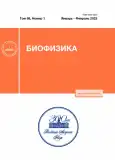Therapeutic effects of high-dose inhaled nitric oxide gas against post-covid syndrome, diabetes or AIDS
- Authors: Vanin A.F1, Pekshev A.V2, Pechyonkin E.V3, Vagapov A.B2, Sharapov N.A2
-
Affiliations:
- N.N. Semenov Federal Research Center for Chemical Physics
- N.E. Bauman Moscow State Technical University
- Stavropol State Medical University
- Issue: Vol 68, No 1 (2023)
- Pages: 142-149
- Section: Articles
- URL: https://journals.rcsi.science/0006-3029/article/view/144414
- DOI: https://doi.org/10.31857/S0006302923010167
- EDN: https://elibrary.ru/OBGWMC
- ID: 144414
Cite item
Full Text
Abstract
About the authors
A. F Vanin
N.N. Semenov Federal Research Center for Chemical Physics
Email: vanin.dnic@gmail.com
Moscow, Russia
A. V Pekshev
N.E. Bauman Moscow State Technical UniversityMoscow, Russia
E. V Pechyonkin
Stavropol State Medical UniversityStavropol, Russia
A. B Vagapov
N.E. Bauman Moscow State Technical UniversityMoscow, Russia
N. A Sharapov
N.E. Bauman Moscow State Technical UniversityMoscow, Russia
References
- А. В. Шиповалов, А. Ф. Ванин, О. В. Пьянков и др., Биофизика, 67 (5), 969 (2022).
- A. F. Vanin, V. A. Tronov, and R. R. Borodulin, Cell Biochem. Biophys., 79, 93 (2021).
- А. Ф. Ванин, Д. И. Телегина, В. Д. Микоян и др., Биофизика, 67 (5), 938 (2022).
- Е. В. Печёнкин, А. В. Коврижкин, А. В. Пекшев и др., Биофизика, 67 (6), 1251 (2022).
- А. Ф. Ванин, А. В. Пекшев, А. Б. Вагапов и др., Биофизика, 66 (1), 183 (2021).
- L. J. Ignarro, Pharmacol. Toxicol., 67, 1 (1990).
- P. C. Ford, Inorg. Chem., 49, 6226 (2010).
- A. A. Timoshin, V. L. Lakomkin, A. A. Abramov, et al., Eur. J. Pharmacol., 765, 525 (2015).
- A. F. Vanin, Cell Biochem. Biophys., 77, 279 (2019).
- А. Ф. Ванин, Биофизика, 65, 4, 421 (2020).
- A. F. Vanin, Appl. Magn. Reson., 51, 851 (2020).
- V. Yu. Titov and A. N. Osipov, Redox Rep., 22, 2 (2017).
- T. H. Han, J. M. Fucuto, and J. C. Liao, Nitric Oxide Biol. Chem., 10, 74 (2004).
- Q. Li, C. Li, H. K. Mahtani, et al., J. Biol. Chem., 289, 19917 (2014).
- A. S. Hurtsen, I. Z. Nilsson, E. M. Dogan, et al., Drug Design, Development &Therapy, 14, 635 (2020).
- F. Blasina, L. Vaamonde, F. Silvera, et al., Pulmonary Pharmacol. Ther., 54, 68 (2019).
- Yu. P. Vedernikov, P. I. Mordvintcev, I. V. Malenkova, et al., Eur. J. Pharmacol., 211, 313 (1992).
- А. Ф. Ванин, Биофизика, 65, 818 (2020).
- S. Castro-Gonzalez, M. Colomer-Lluch, and R. Serra-Moreno, AIDS Research and Human Retroviruses, 34, 9, 739 (2018).
- Н. Н. Петрищев, О. В. Халепо, Ю. А. Вавиленкова и др., Региональное кровообращение и микроциркуляция, 19, 3 (2020).
- М. Ю. Мартынов, А. И. Боголепов и А. Н. Ясманова, Журн. неврологии и психиатрии им. С.С. Корсакова, 121, 93 (2021).
- L. Perico, A. Benigni, F. Casivaghi, et al., Nat. Rev. Nephrol., 17, 46 (2021).
- A. K. V. Iyer, Y. Rojansakul, and N. Azad, Nitric Oxide Biol. Chem., 42, 9 (2014).
- Y. M. Kim, H. T. Chung, R. L. Symmons, et al., J. Biol. Chem., 275, 10954 (2000).
Supplementary files










